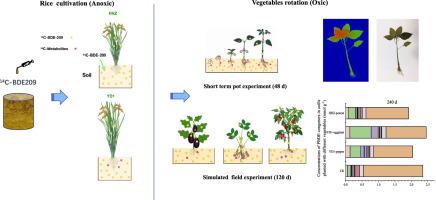Environmental Pollution ( IF 8.9 ) Pub Date : 2020-06-28 , DOI: 10.1016/j.envpol.2020.115082 Pengfei Zhao 1 , Wei Wang 2 , Joann K Whalen 3 , Sufen Zhang 2 , Qingfu Ye 2

|
This work evaluated the debromination and uptake of 14C-labeled BDE-209 in rice cultivars grown in anoxic soil for 120 days (d) followed by cultivation of vegetables (peanut, eggplant and pepper) in oxic soil (120 d). Degradation of BDE-209 to lower polybrominated diphenyl ethers (PBDEs) occurred in cultivated soils, and more metabolites were released in oxic soil than in anoxic soil. The crop rotation from anoxic to oxic greatly enhanced the dissipation of BDE-209 in the soil (P < 0.05), in which the dissipation in anoxic soil planted with Huanghuazhan (HHZ, indica) and Yudao 1 (YD1, indica) were 6.8% and 2.4%, respectively, while in oxic soil with peanut and pepper were increased to 25.8% and 21.7%, respectively. The crop rotation also enhanced the degradation of BDE-209 in the soil, the recovered BDE-209 in soil after 120 d anoxic incubation with YD1 was 81.1%, but it decreased to 47.8% and 45.8% after another 120 d oxic incubation. Bioconcentration factors were between 0.23 and 0.36 for rice, eggplant and pepper but reached to 0.5 in peanut, which contains more lipids in the edible portion than the other test crops. The estimated daily intake for vegetables was 0.01–0.07 μg BDE-209-equivalent kg−1 bw day−1, which is at least two orders of magnitude below the maximum acceptable oral dose (7 μg kg−1 bw day−1). Our work confirms that crop rotation from rice to vegetable enhanced the dissipation and debromination of BDE-209 in the soil, and indicate that sequential anoxic-oxic rotation practice is considered to be effective in remediation of environmental pollutants.
中文翻译:

缺氧和有氧作物轮作中十溴代二苯醚的运输和降解。
这项工作评估了缺氧土壤中生长120天的水稻品种中14 C标记的BDE-209的脱溴和吸收(d),然后在含氧土壤中种植蔬菜(花生,茄子和胡椒)(120 d)。在耕作土壤中,BDE-209降解为低级多溴二苯醚(PBDEs),并且在含氧土壤中释放的代谢产物比缺氧土壤更多。从缺氧到有氧的轮作大大提高了BDE-209在土壤 中的耗散(P <0.05),其中黄花站(HHZ,印度)和玉道1(YD1,印度)种植的缺氧土壤中的耗散。)分别为6.8%和2.4%,而在有氧土壤中,花生和胡椒分别增至25.8%和21.7%。作物轮作还增强了土壤中BDE-209的降解,YD1缺氧孵育120 d后土壤中回收的BDE-209为81.1%,但再经过120 d缺氧孵育后还原为47.8%和45.8%。水稻,茄子和辣椒的生物富集系数在0.23至0.36之间,而花生的生物富集系数达到0.5,与其他试验作物相比,可食部分的脂质含量更高。蔬菜的估计每日摄入量为0.01–0.07μgBDE-209等效千克-1 bw天-1,比最大可接受口服剂量(7μgkg -1 bw天-1)低至少两个数量级。)。我们的工作证实,从水稻到蔬菜的轮作会增强土壤中BDE-209的消散和脱溴作用,并表明顺序的缺氧-缺氧轮作实践被认为可以有效地修复环境污染物。



























 京公网安备 11010802027423号
京公网安备 11010802027423号